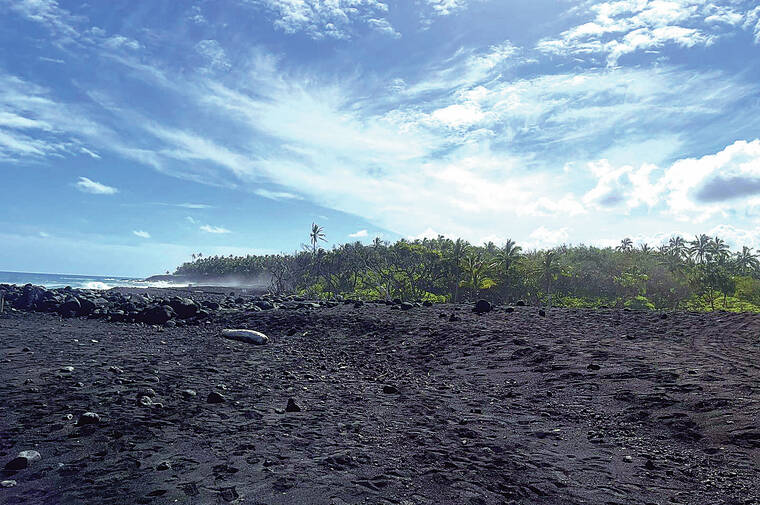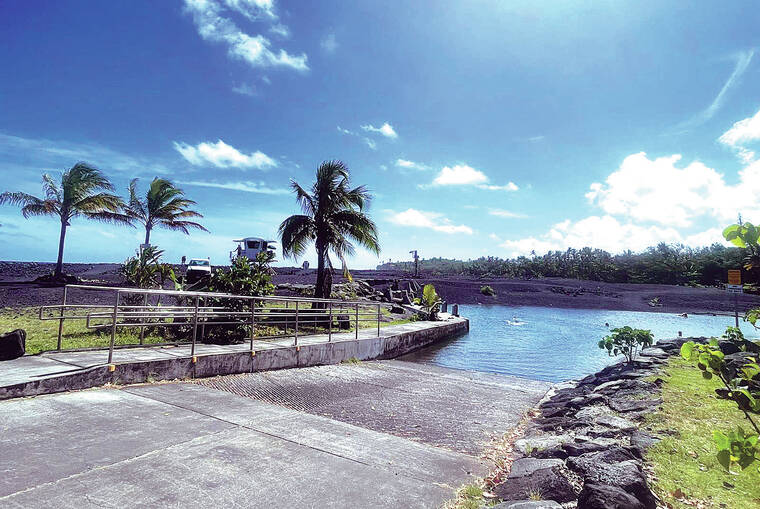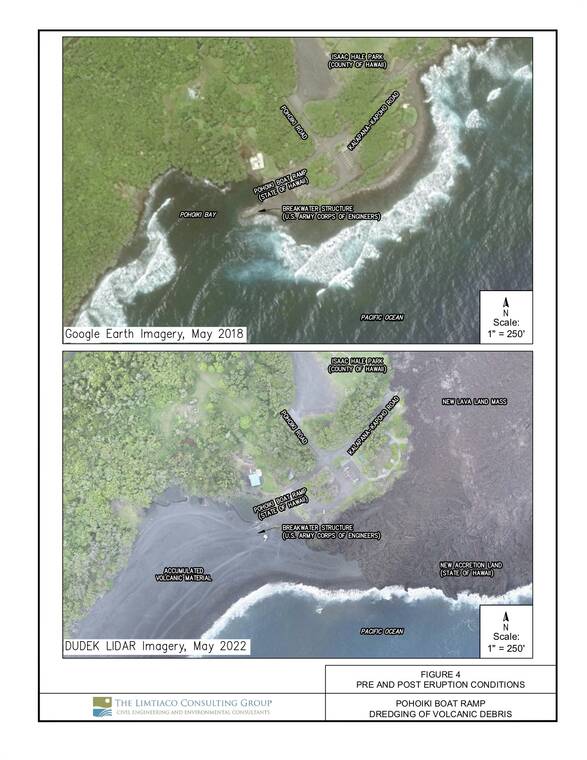The reopening of the Pohoiki Boat Ramp is one step closer after a draft environmental assessment for the dredging project was published Sunday.
The draft EA, which was published in the state Office of Planning and Sustainable Development’s Environmental Notice, anticipates that dredging the entirety of the beach in front of the boat ramp would have minimal environmental impact.
The ramp — the sole access point for boats to enter the ocean in Puna — was cut off from the water in 2018 during the eruption of Kilauea, when lava entering the sea created a black sand beach roughly 11.6 acres in size.
In order to reopen the ramp, the Division of Boating and Oceanic Recreation proposed in 2022 a trio of options that would dredge channels through the beach. Two of those proposals were relatively fast and cheap — between $3.6 and $5.2 million — while a third, which would install breakwaters to protect the channel from refilling, would cost more than $60 million and take years to complete.
DOBOR changed the scope of the project shortly thereafter to its current incarnation: removing as much of the beach as possible, with the sediment being dumped on nearby new land created by the eruption.
The draft EA estimates that removing the entire beach — roughly 175,000 cubic yards of volcanic material — would cost about $40 million. Because the project will be handled by DOBOR, the cost of the dredging will paid using state funds, with additional allocations by the Federal Emergency Management Agency.
“If there are insufficient funds to fully restore Pohoiki Bay to pre-eruption conditions, then the proposed action would be modified to dredge the most area that funds allow,” the assessment reads.
While Gov. Josh Green included in his 2023 state budget request $40 million for the Pohoiki restoration project, the current draft of that bill only includes $10,000. Another bill, introduced by Puna Rep. Greggor Ilagan, that would have allocated funds for the dredging stalled in February.
Included in the assessment is a letter from Lena Carver, who owns a property adjacent to Pohoiki Bay, expressing concerns about the impacts of the project.
“Our main concern is the dredging of the whole bay and impact on our property and those who own properties near the bay,” Carver’s letter read. “We do not want our properties to be under water, so please make a wise decision.”
Carver, however, added that the dredged sediment could be used to shore up nearby properties and better shield them from sea level rise.
The draft EA does not include specific dates for the project, merely estimating that the final EA “may” be completed in 2023, and that necessary permits for the project “may” be acquired this year so construction could begin in 2024.
If that estimated schedule is accurate, it would put the reopening of the ramp more than six years after it was cut off by the eruption.
“It’s been a little long, time-wise,” said Puna resident Ku‘ulei Kealoha-Cooper, whose family owns property adjacent to the beach. “I’m very pleased with the progress so far, but there’s still a lot of work left to do.”
The draft EA includes interviews with Kealoha-Cooper and other Native Hawaiian residents where they explain the history and importance of the boat ramp and urge the state to complete the project as quickly as possible.
Kealoha-Cooper reiterated that point Monday, noting that next month, Puna will have gone without access to the ocean for five years, and Puna fishermen are reaching a breaking point.
“Hopefully with a new administration, DOBOR will decide to put this back on the front burner,” Kealoha-Cooper said.
The assessment also states that a side effect of the dredging is that a series of nearby hot ponds that formed after the eruption will have to be destroyed, an outcome that is welcomed by some residents.
The report cites residents’ complaints about unclothed bathers at the hot ponds who frequently leave trash in the area, and Carver’s letter adds that the hot ponds’ destruction will “remove the existing nudity and open sexual gatherings.”
With the draft assessment completed, a 30-day public comment period is in place until May 23.
The assessment can be read at tinyurl.com/3eye4a69, and comments can be submitted to finn.d.mccall@hawaii.gov and copied to trevor@tlcghawaii.com.
Email Michael Brestovansky at mbrestovansky@hawaiitribune-herald.com.











